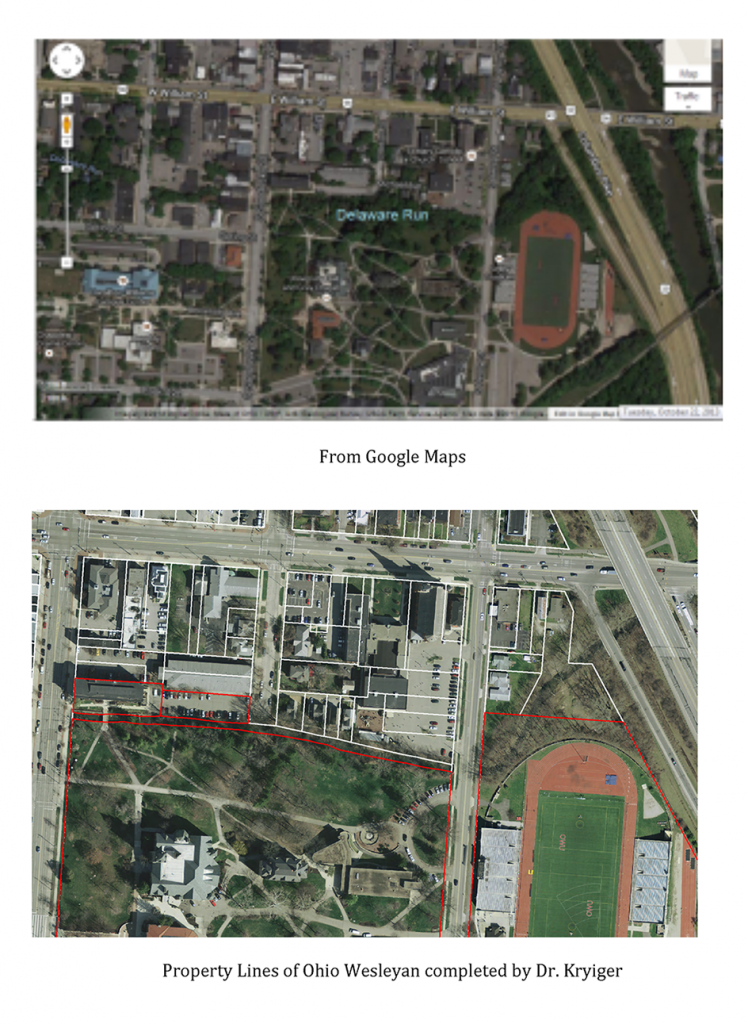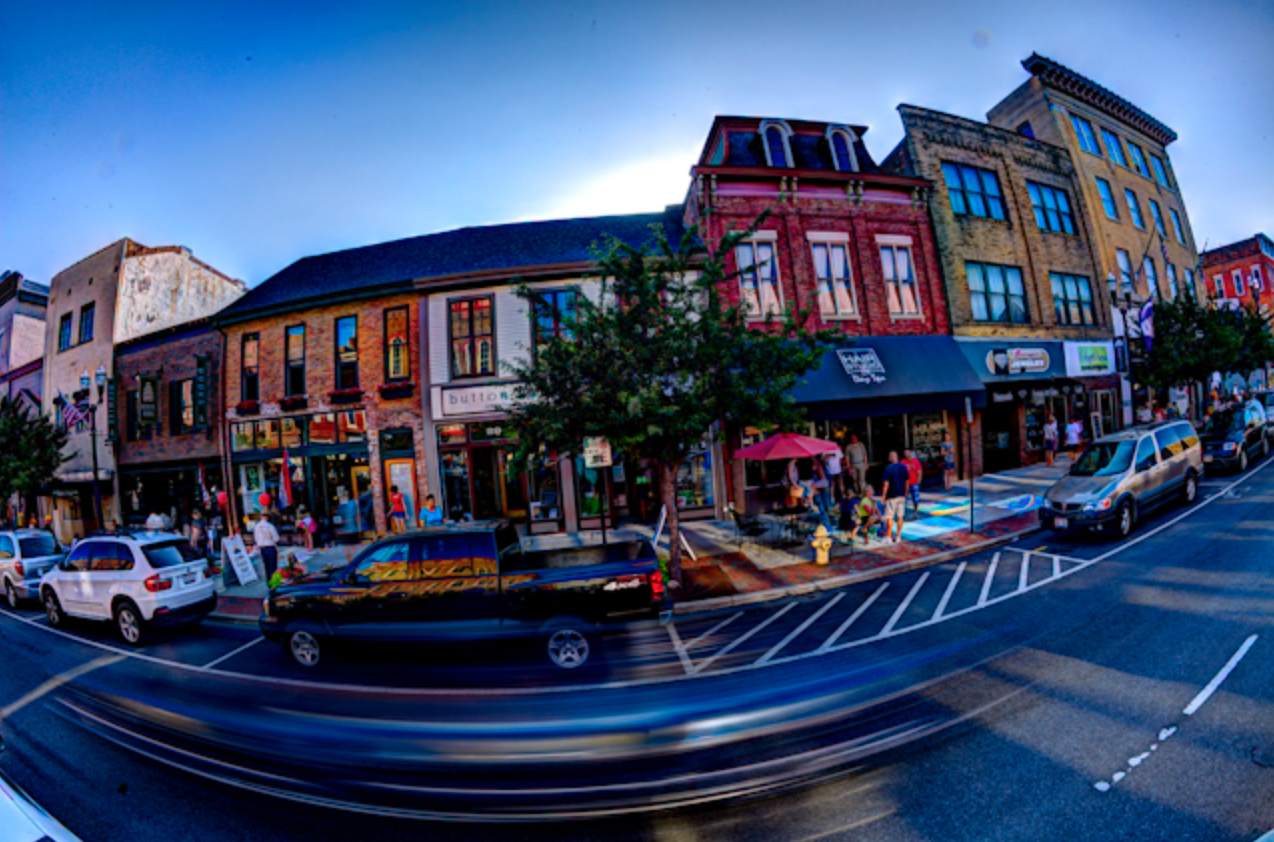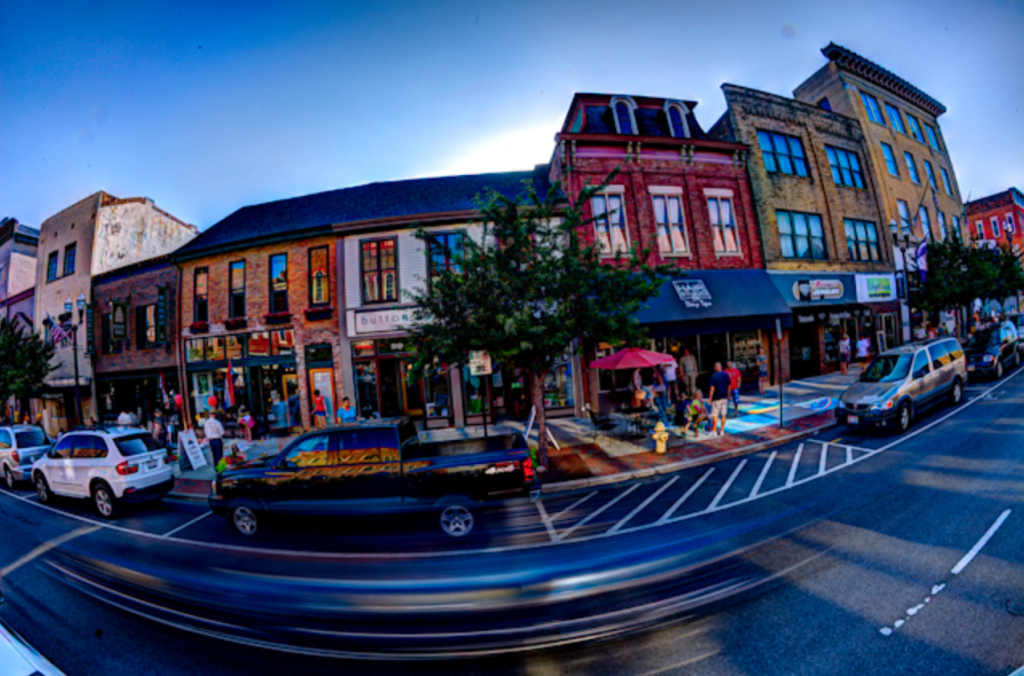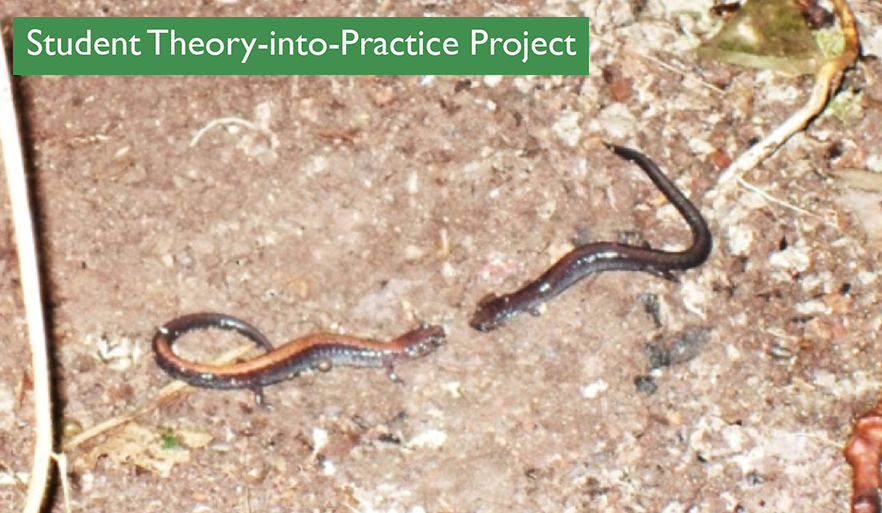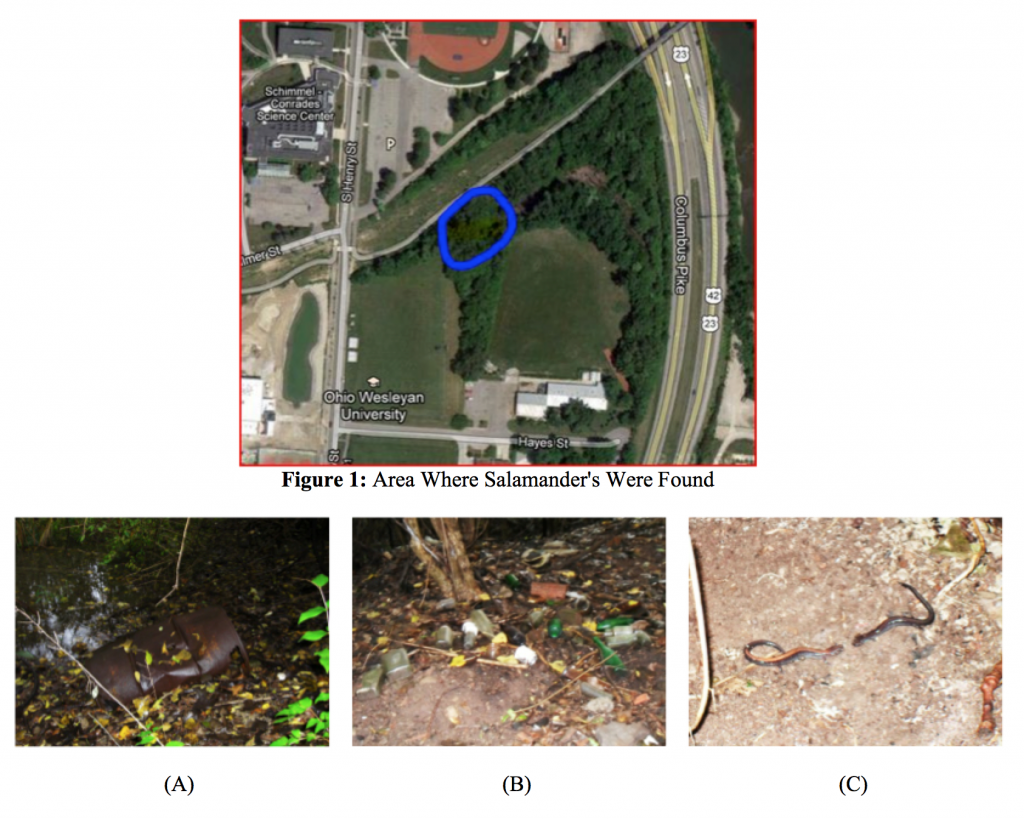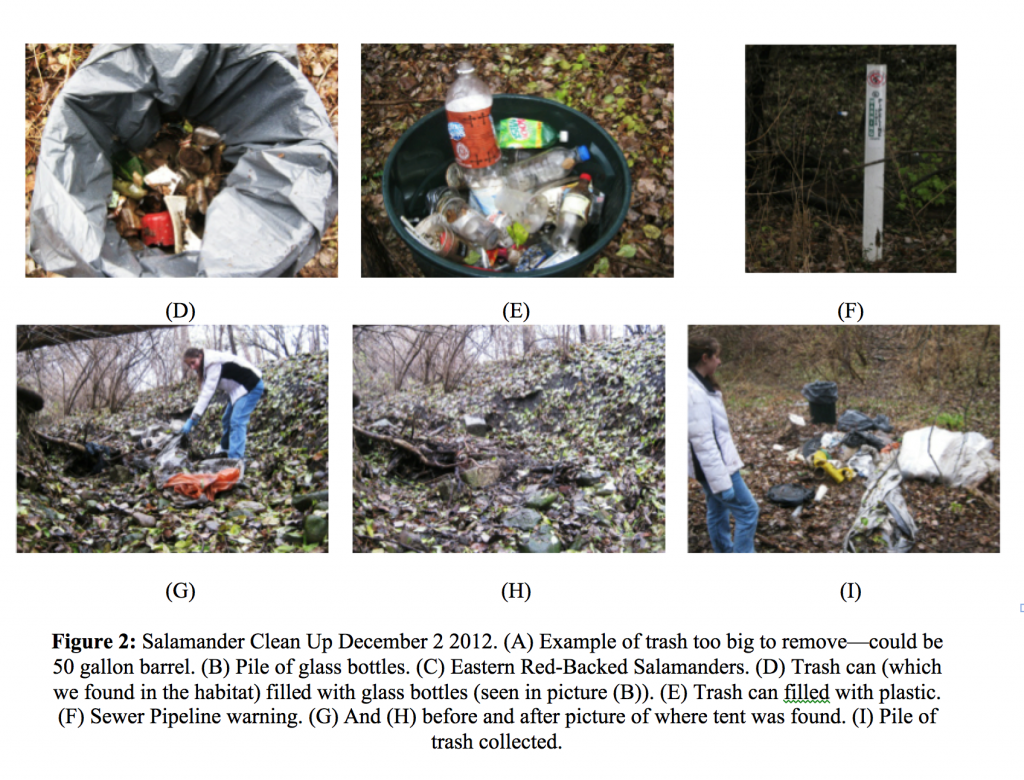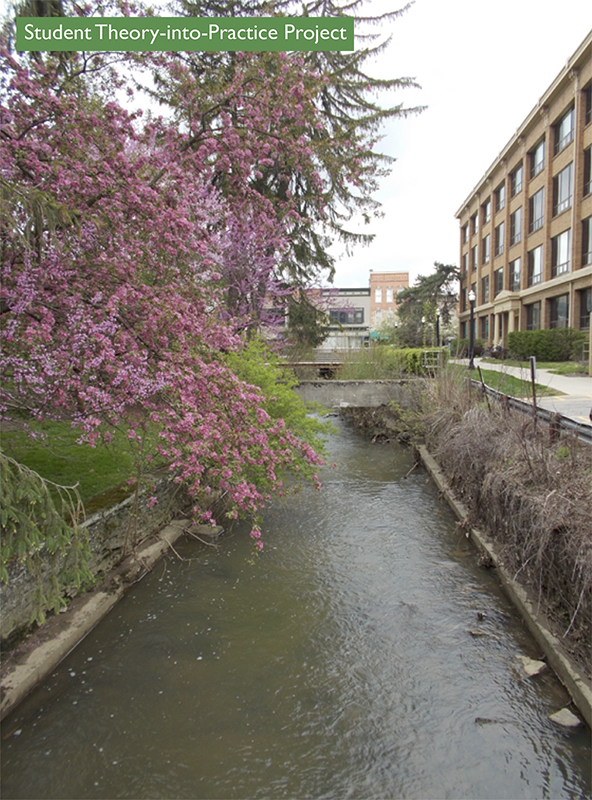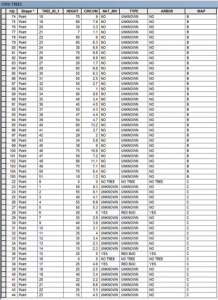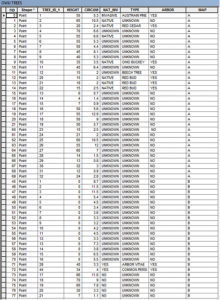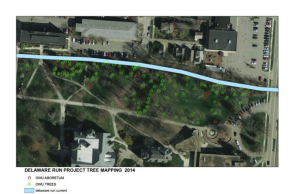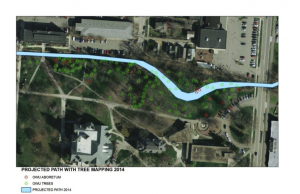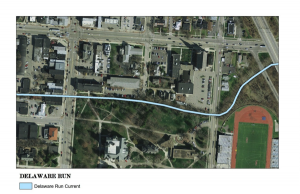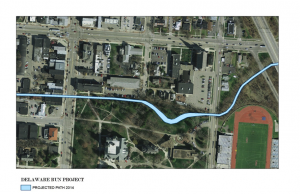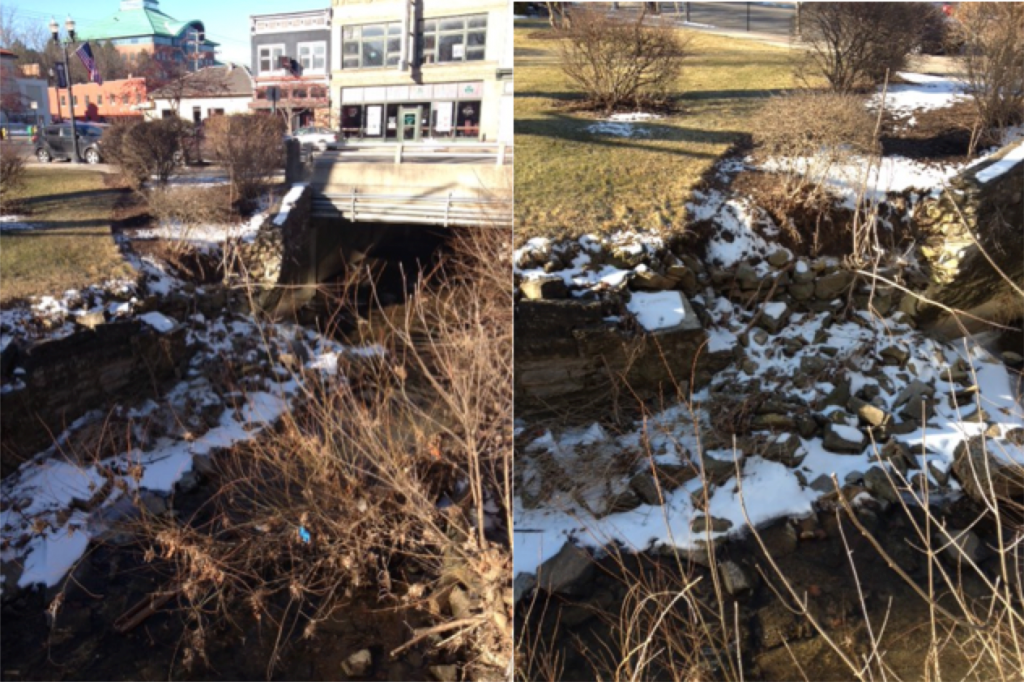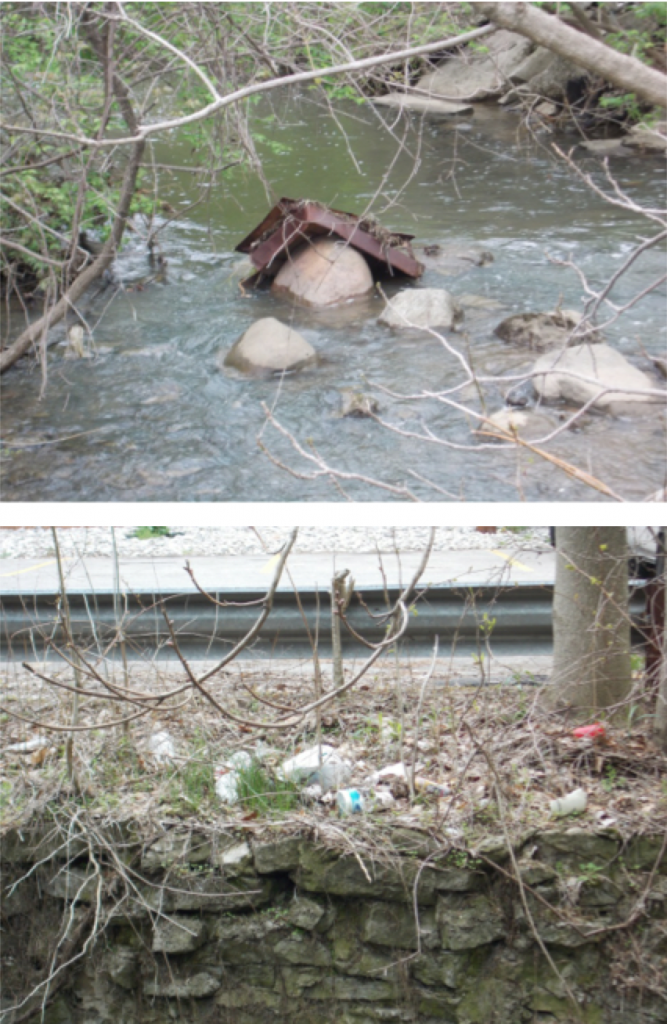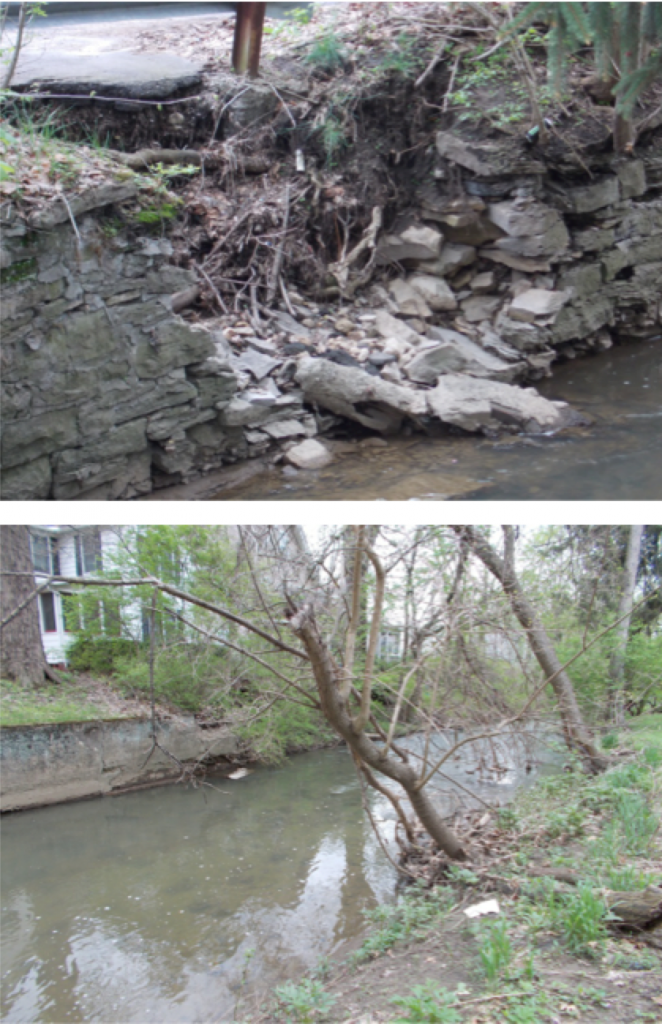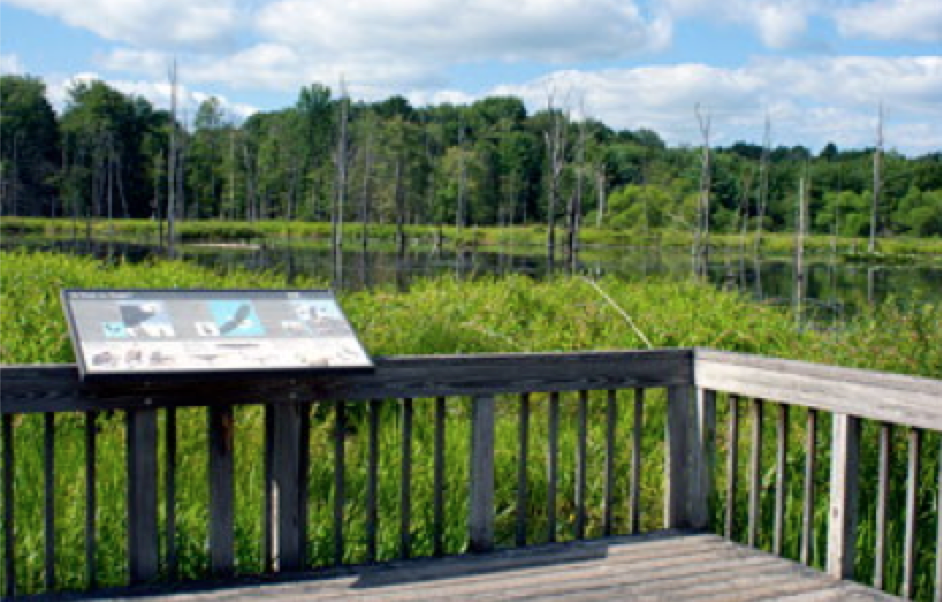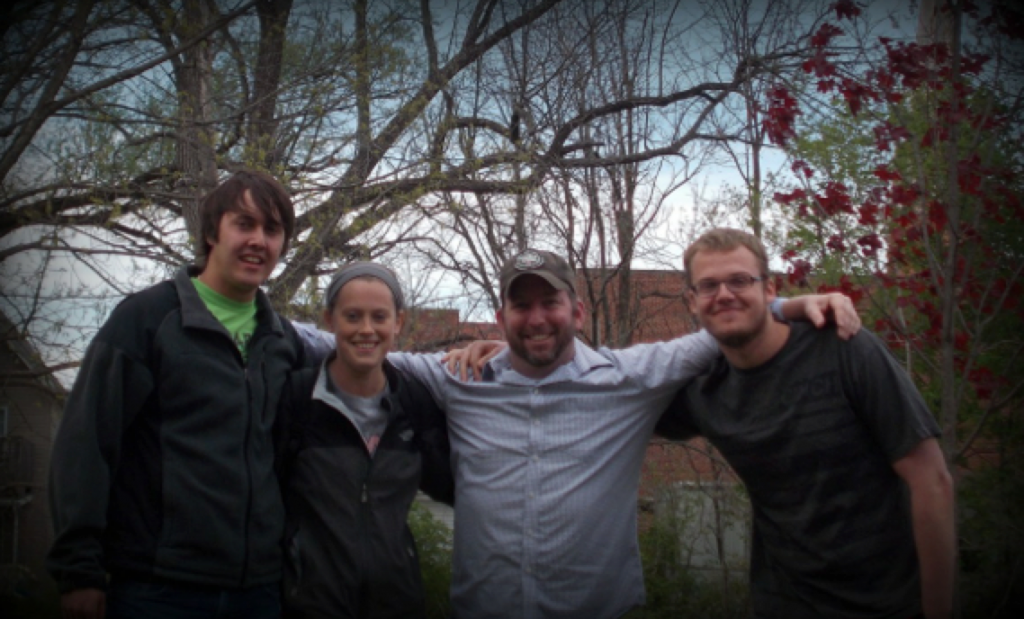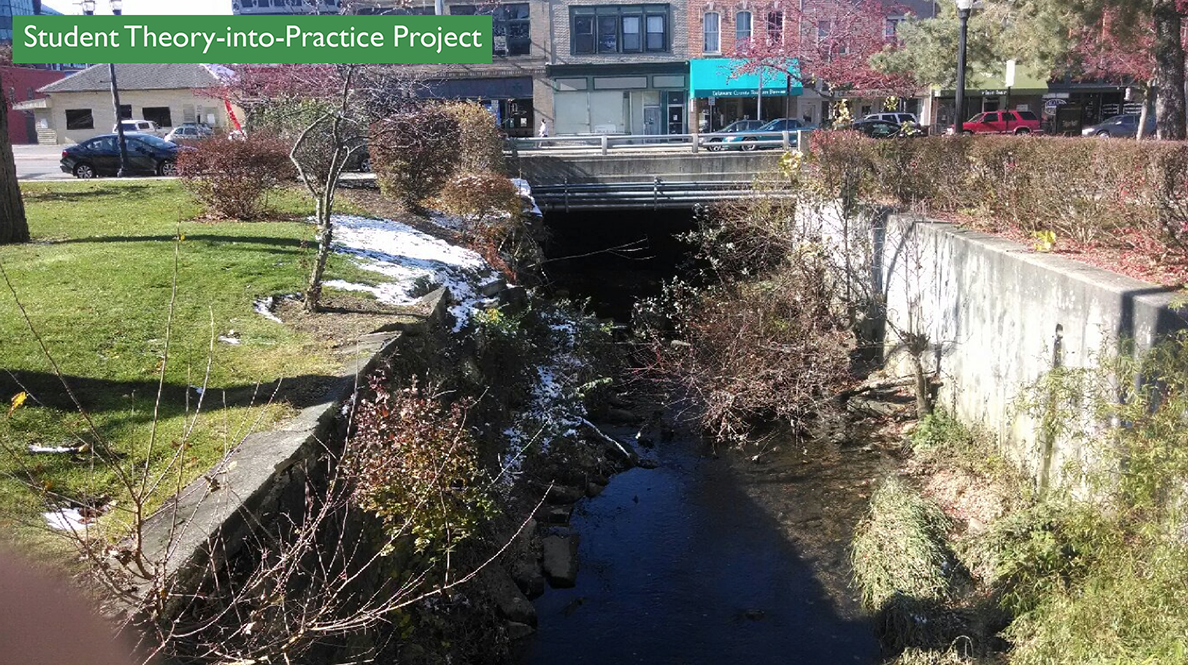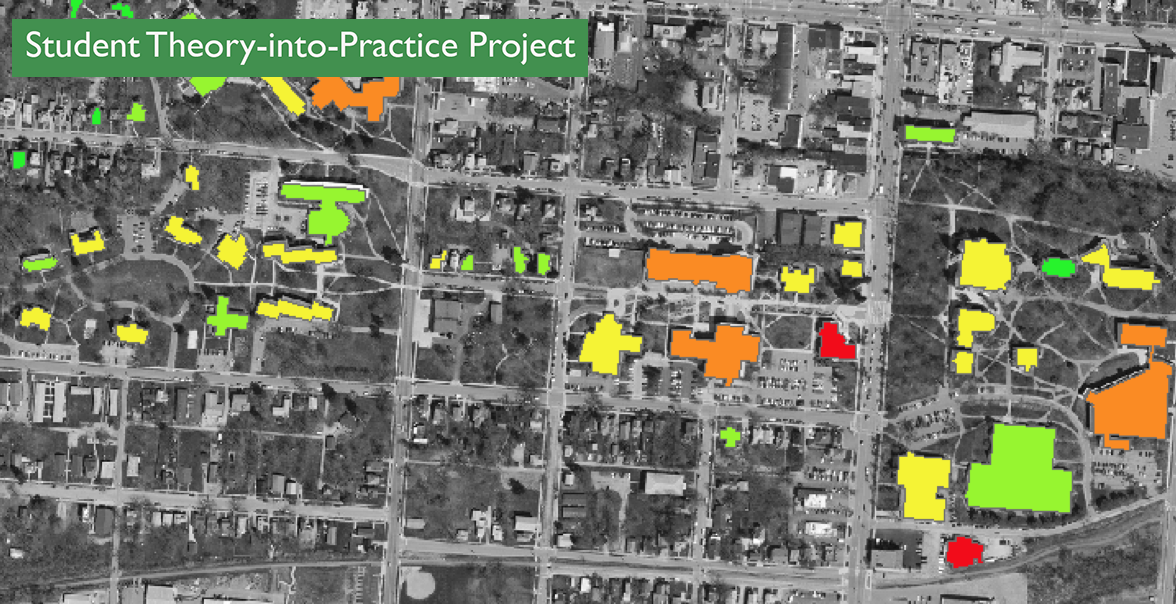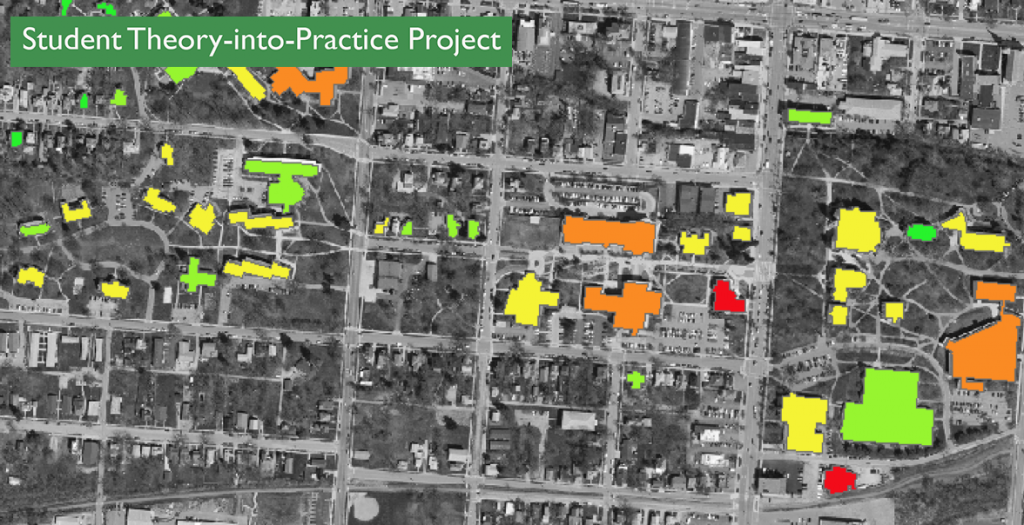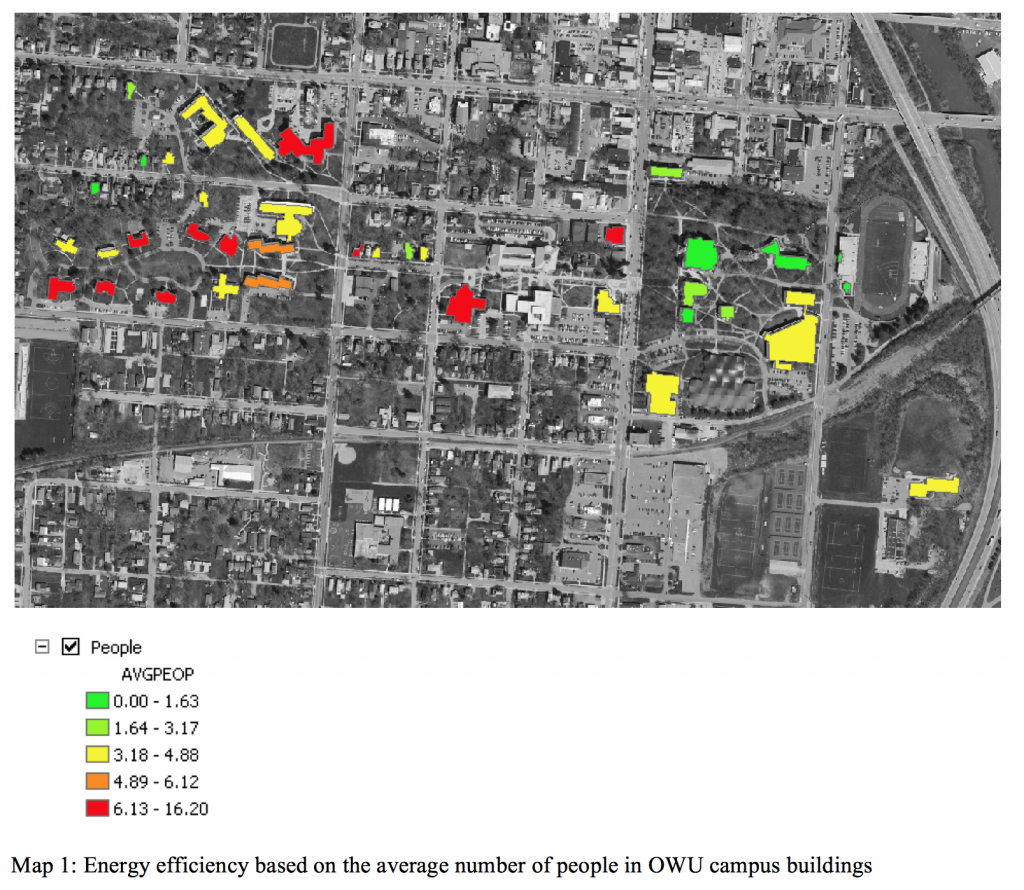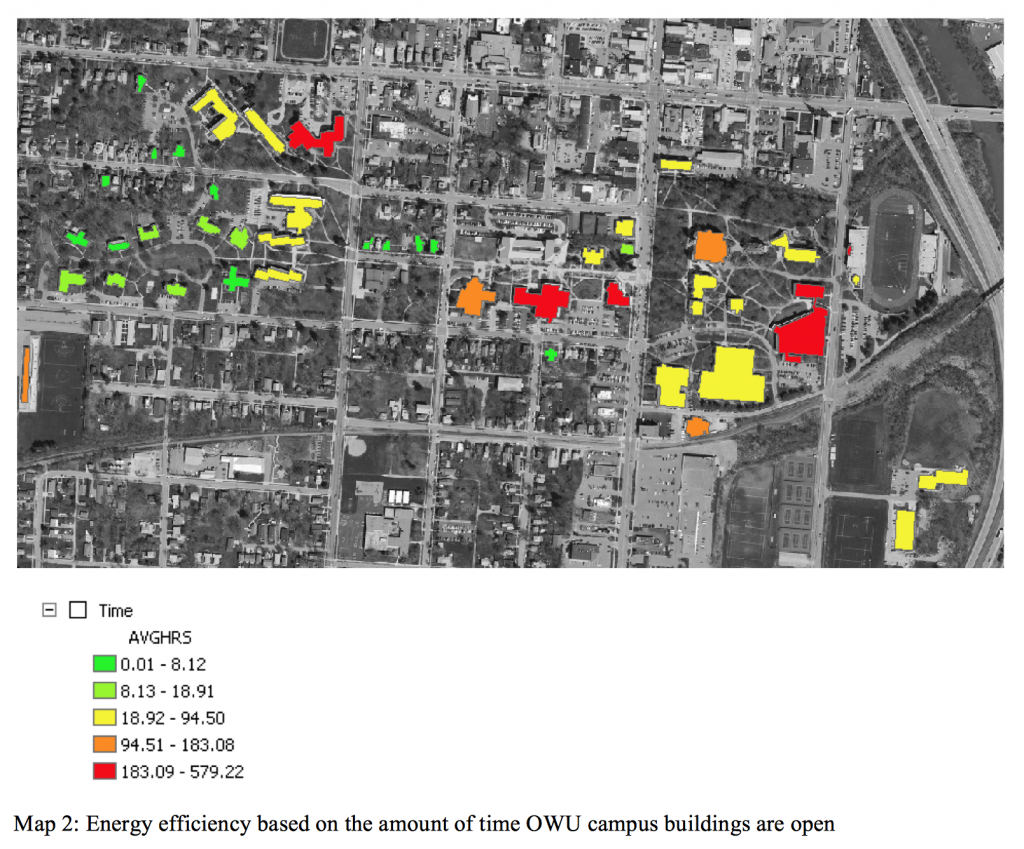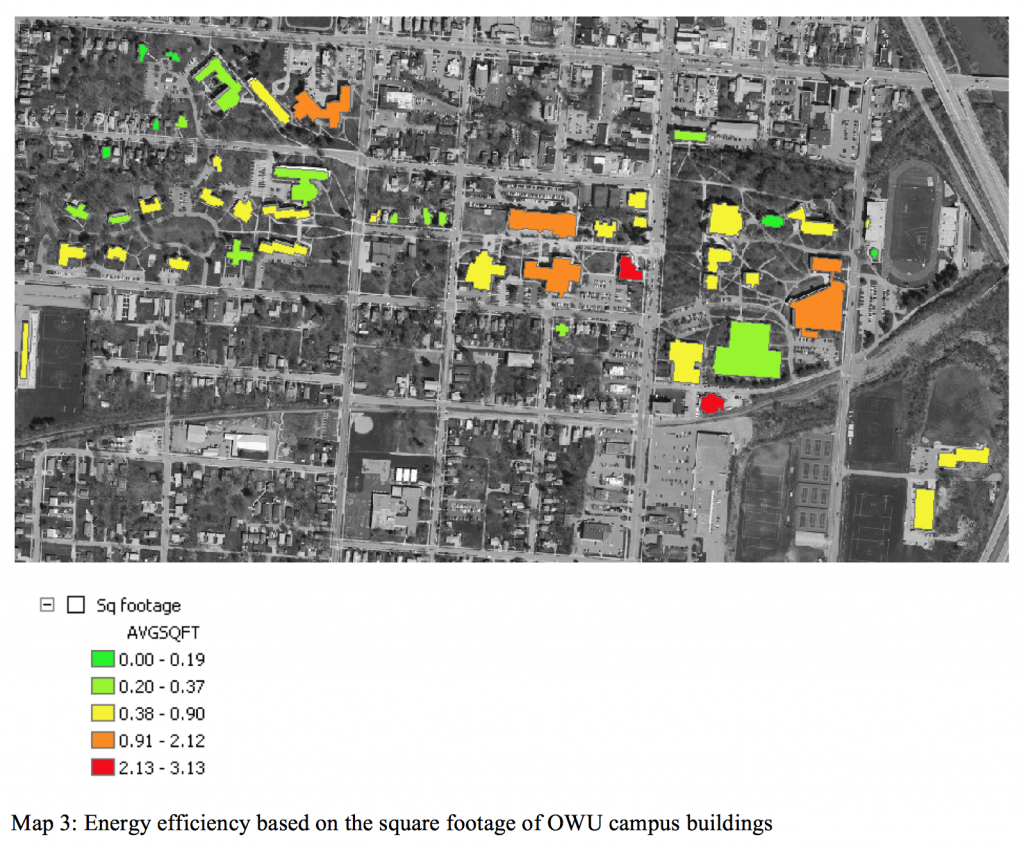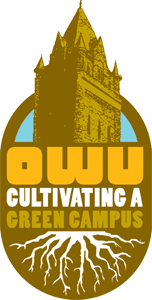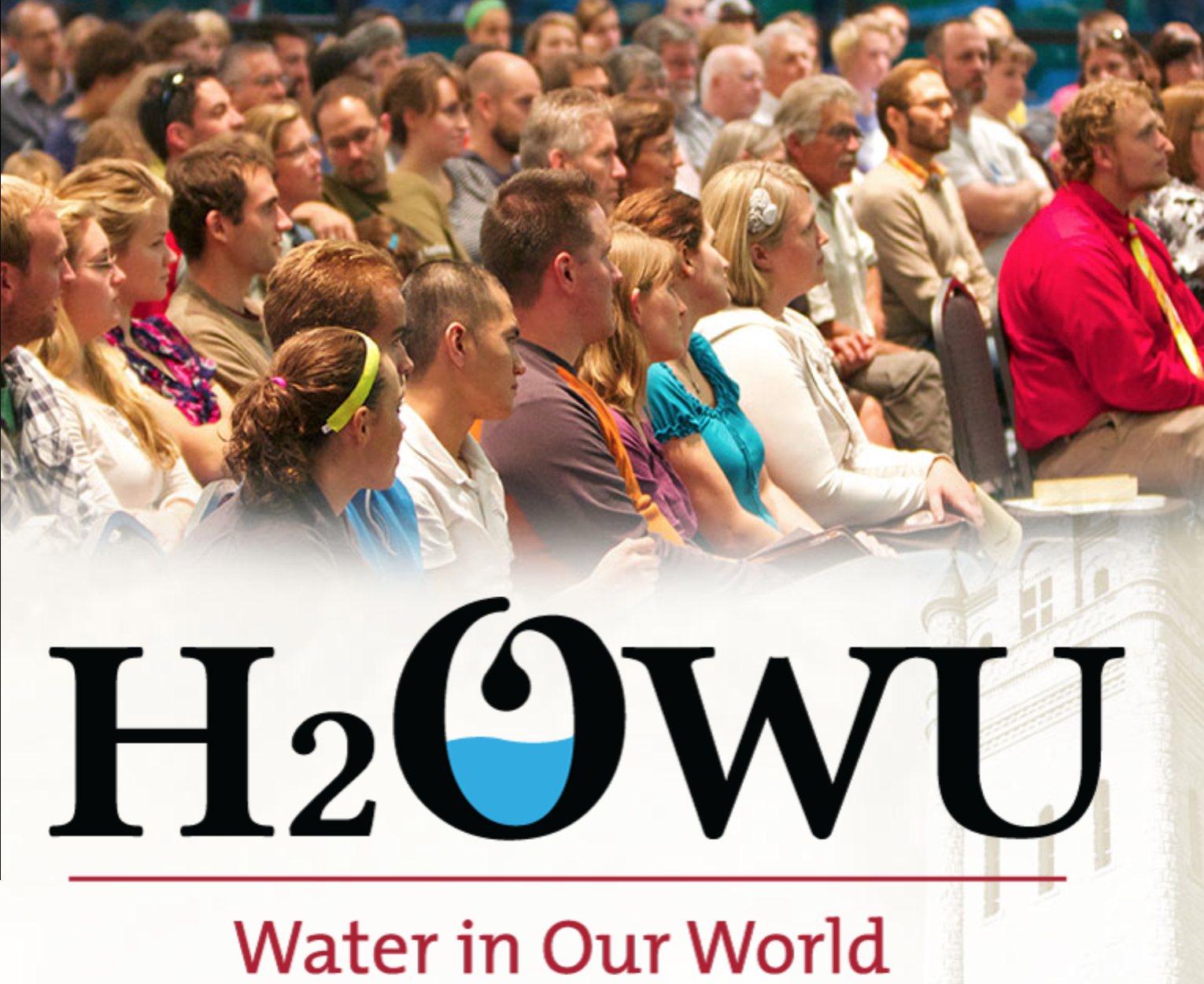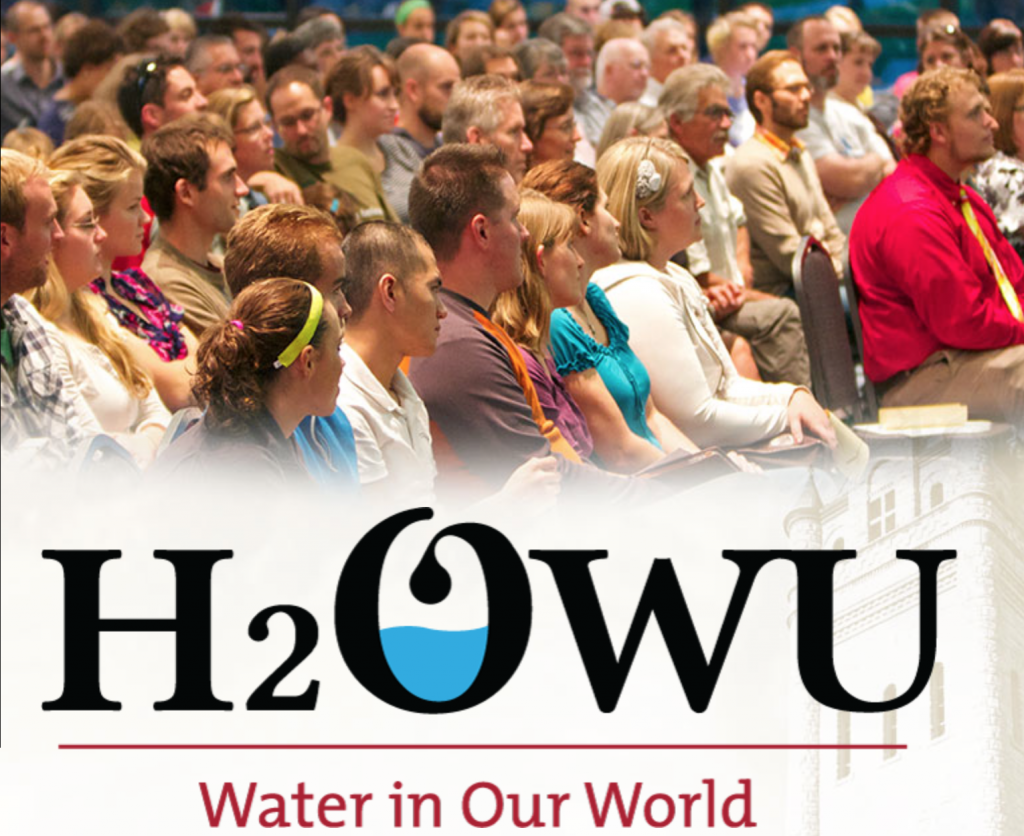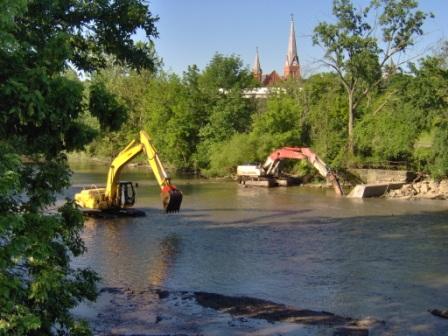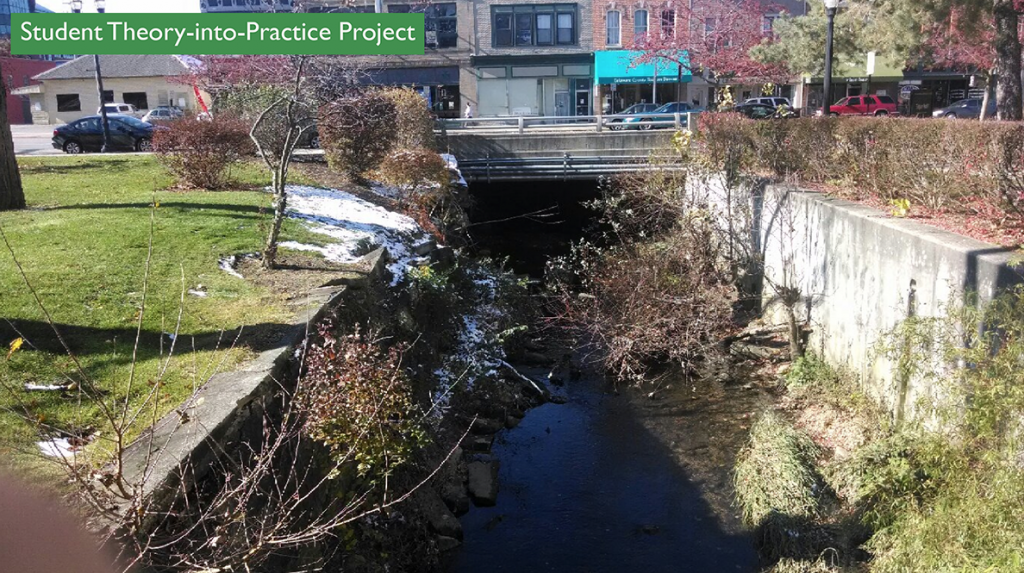
In the Spring of 2012 a team of students assessed the current ecological state of Delaware Run, adjacent to the academic side of the OWU campus. The ultimate goal, explored in a spring of 2014 project by a different group of students, is to re-naturalize and restore the stream, ideally with a focus on urban water, wetlands and wildlife.
Delaware Run Restoration Preliminary Research and Analysis
Ohio Wesleyan University and the City of Delaware
December 2013
Christopher Badenhop, Thomas Bain, Dr. John Krygier, Kristen Piper (City of Delaware Watershed Coordinator), Sarah Sanders, Theresa Wolfgang
Summary
The purpose of the Delaware Run Restoration Preliminary Research and Analysis project is to assess the possibility of the dechannelizing the Delaware Run in Delaware Ohio near the campus of Ohio Wesleyan. This assessment is to research the historical and current state of the Delaware Run in geographical and scientific terms. As a group, we wanted to what work needed to go into doing such a large-scale project. Below describes the preliminary work to gain an understanding of how to begin the process of dechannelizing an urban stream like the Delaware Run. There are also images attached of invasive plant species, the current conditions of the Delaware Run, and maps describing the historical and current geography of the area.
Geographical History
The Delaware Run is small stream, or as in local terms “creek” (often pronounced crik), that runs through the heart of the bustling North Columbus suburban community of Delaware, Ohio. With its location so entrenched in the downtown area of the town of roughly 35,000 people, undoubtedly there have been many changes to its ecological, as well as, its physical features since European settlement began around the turn of the nineteenth century. Today, the Delaware Run is located near the campus of Ohio Wesleyan University and is merely a simple trench that is overgrown with invasive species, has crumbling infrastructure, and in general no longer possesses the natural ability to reach its full ecological capacity.
The Delaware Run starts to the west of downtown and ends just northeast of Ohio Wesleyan University’s campus not far from historic Selby Stadium at a confluence with the Olentangy River. Historically, the stream made its way east, and it naturally meandered slightly, slowing the flow of water and allowing for normal ecological functions of a small stream. However, with the march of human progress, the ecological integrity has fallen at the hands of channelization. Today, in large sections of the run, the natural curvatures of the embankments have been replaced with straight cement banks. Also, large portions are no longer visible and have been built over by the expansion of downtown Delaware. These cement banks and elimination of Delaware Run’s natural order has led to an increase in the water’s speed that does not allowing life to flourish. However, now there is the ability to take some corrective action to restore the ecological integrity of the stream as it runs along side the campus of Ohio Wesleyan University.
We identified the Delaware Run’s natural path through much time researching through dusty books courtesy of the Beeghly Library Historical Section. We were able to obtain maps from the late eighteen hundreds that showed the natural meandering path of the stream prior to the current channelization and covering of the majority of the stream. In the future, these maps could serve as potential guides for complete dechannelization. Complete opening and dechannelization of the stream is rather ambitious, and it is much more likely that these maps can be used as evidence that the stream did have a natural curvature. They could serve to help dechannelization efforts along Ohio Wesleyan University’s campus.
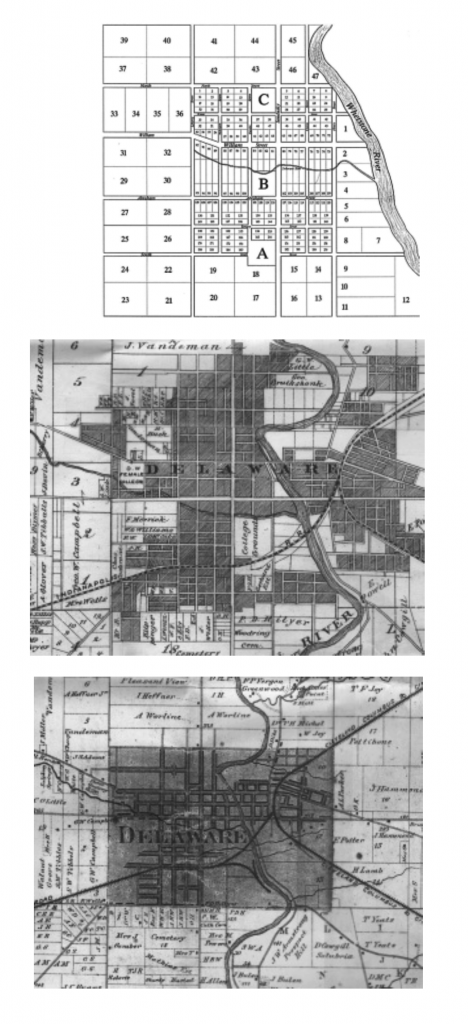
Scientific History
In 1993, a study done by Dr. John Gatz and Dr. Amy Harig showed a decline in biotic integrity of the Delaware run over the previous fifty years. They found that by 1940, the run had already been degraded by human contact. As the population grew from 9000 to 20,000 by 1992, there was an increase in degradation seen at the Run. Agriculture began to increase which caused more runoff and siltation from the chemicals used on the fields. Urban runoff including petroleum products also increased in the Run. Also, the Run began to see a loss of riparian vegetation due to erosion. Habitat loss through channelization was also another issue they encountered in their research.
After looking at the abiotic factors of the run they turned to the biotic factors. There was a clear decrease in certain species of fish found in 1940 and an increase in pioneer species. They concluded that this change in species showed the instability of the environment, because pioneer species are known to inhabit new or frequently changing environments. When looking at the individual fish they found there was an increase in deformities, eroding fins, lesions and tumors from 1940 to 1992.
Another study, completed in 1999 on the Delaware Run, showed an increase in contamination of the water since the 1993 study. Of the selected tributaries in Delaware county, the Delaware Run had one of the highest degrees of metal contamination (aluminum, chromium, copper, and zinc) and organic contamination (phosphorous and sulfur). The metal contamination was the result of polluted runoff from city streets, sidewalks, metallic particles from car brakes, leached materials from concrete, aluminum and copper gutters, and galvanized metal products. Sewage contamination had increased along with pesticide runoff such as Chlordane. E. Coli was also recorded in the run that could have added to many illnesses in Delaware at this time. The natural sulfurous groundwater found in the area seeped into the run and left a whitish precipitate and odor that allowed only tolerant fish and macro-invertebrate communities to thrive in it, however toxic levels hindered many aquatic compounds. After this study, scientists still found that the Delaware run still had a predominance of highly tolerant and pioneering fish species indicating that the environment was still unstable.
FLOW or Friends of the Lower Olentangy watershed did an assessment of the Delaware Run in 2002, and they were able to find more problems that the run was been enduring along with other ecological measurements. The first problem they found was that the run was no longer meeting the WWH (Warmwater Habitat) standards, which it had been in the previous years and studies mentioned above. Scientist believed it could have been done due to the increase in phosphorous, contaminated sediment runoff, habitat modification and sewage. They were able to conclude this by finding only fair fish population and poor macro-invertebrates communities. Species of fish that are environmentally sensitive were lacking in the run while 67% of the fish collected for the assessment were pollution-tolerant species. Bottom-dwelling inverts were of low diversity and were dominated by pollution-tolerant forms such as the black fly larvae and flat worms.
After reviewing three ecological assessments of the Delaware run starting from the 1940s to 2002 it can be easily seen that the problems have become more of an issue through time. Population increase in Delaware has caused more chemical runoff, sewage, and debris to enter the run that then affects the biotic factors that live within or around the water.
Restoration
After meeting with Kristen Piper, Watershed Coordinator of the Upper Olentangy, we became aware of what plans the city has for the Delaware Run. Their first order of business is fixing the wall that has collapsed near Sandusky Street. If the wall continues to collapse it could affect the bridge, which the road is built on. The Delaware Run’s banks as they are now do not abide by the OSHA codes. The sides of the run drop off above the maximum required height. In order to fix this, they would need to slope to the south side of the run. Since this area has been channelized for so long, trees located on the banks of the run would need to be cut down. The city has been researching ways of saving the larger trees, however none have been proposed yet.
Current State of the Delaware Run
The current sate of Delaware Run has several issues that are causing damage to it and endangering the Runs ecosystem. Through diligent management of the area each of these could be solved in turn and the Run ecologically improved to provide better habitat and ecological services.
Chemical Edging: The grass of campus runs right up the edge of the wall of Delaware Run. The runoff from this carries chemicals and pesticides that are used in the treatment of the landscape. This Chemical Edging is also the same process used around many of the trees near the run (insert picture). In order to prevent competition and crowding with these trees large amounts of a pesticide is sprayed around them to kill plants and prevent their growth.
State of the Water; There is a fair amount of algae growth in the water (insert photo) which means there is a high chance that it contains sizable amounts of micro-nutrients. These likely do come somewhat from campus, but most likely this is minimal. The presence of these micro-nutrients at these levels means it is most likely from an upstream source, though more research on this certainly possible. Litter is a consistent presence in the Run on campus, ranging from netting to trash to tires.
Presence of Invasive Species; There are several invasive species also present at the Run which will require removal and continual management in order to help restore other species. Many of these invasive species are situated upriver along the banks especially in Blue Limestone Park. For example photos see the Invasive Plant Example Section.
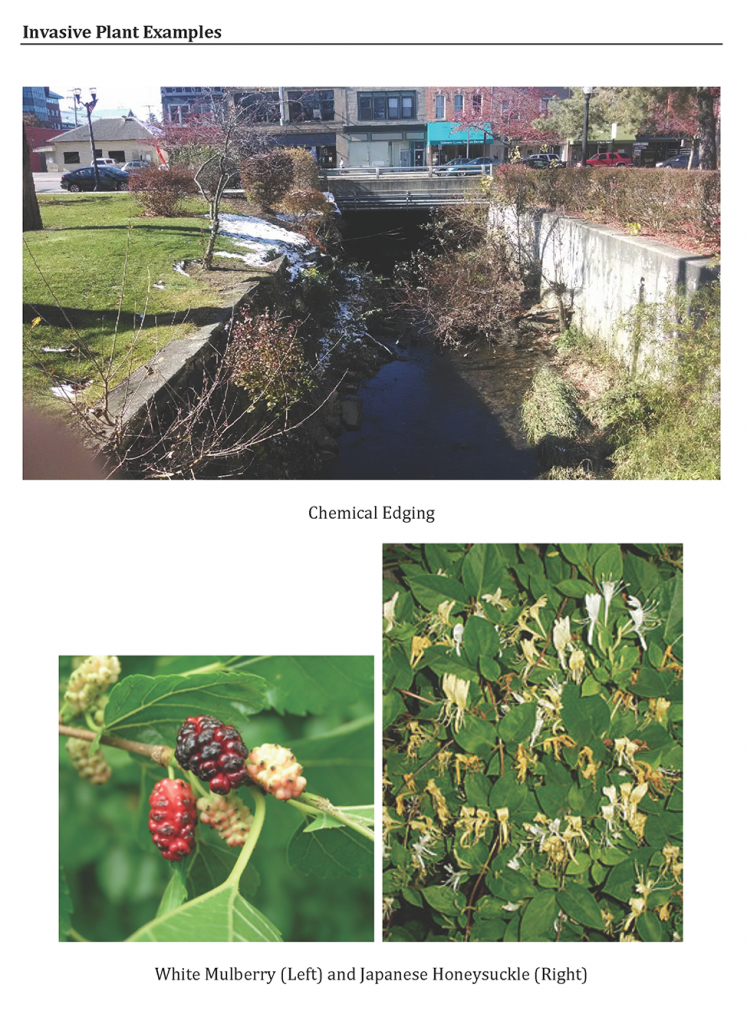
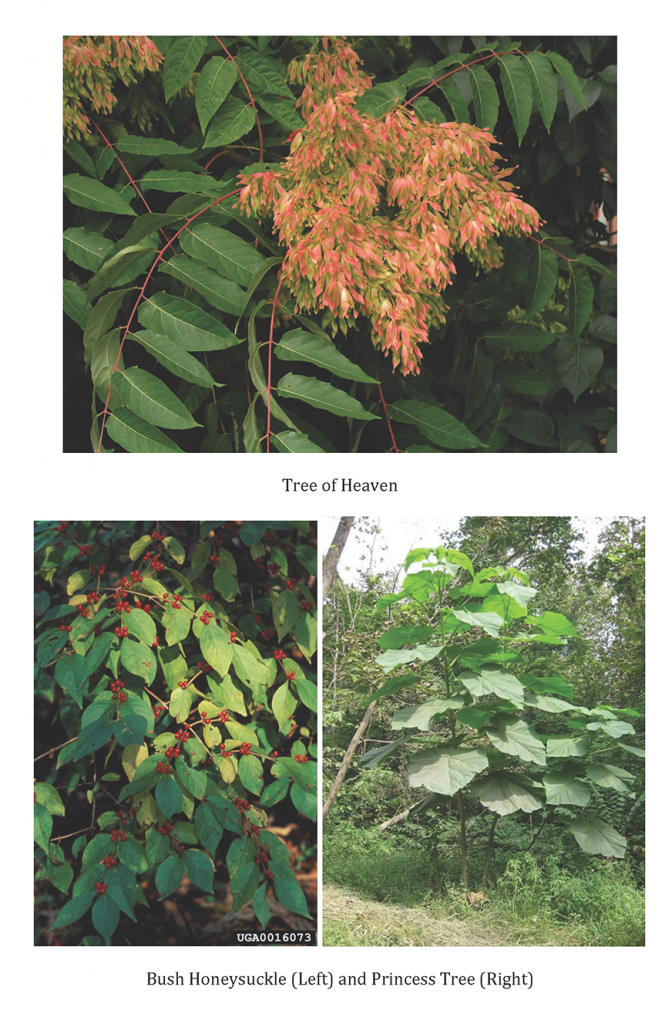
White Mulberry: This invasive plant is native to northern China, and is the size of a small tree.
Tree of Heaven: Another species from China, Tree of Heaven translates directly to ‘foul smelling tree’. Its name derives from the fact that the tree grows very rapidly.
Japanese Honeysuckle: Native to East Asia, Japanese Honeysuckle is a vine that grows on many different trees and plants. It tends to violently displace them and grows incredibly quickly.
Bush Honeysuckle: Native to the temperate areas of East Asia. This plant is even more aggressive than its vine counterpart. Bush Honeysuckle grows incredibly wide and crowds out anything near it. The limbs, which grow together in bundles from the ground before spreading out, can be nearly as thick as a forearm. The plant secretes a chemical into the soil around it which will actually kill off other plants in addition to its crowding. In areas that are sufficiently overgrown removal of the plant revels that all of the underbrush of a forest area can become honeysuckle, leaving nothing but trees and dirt.
Princess Tree: This tree is native to central and western China. Princess tree is identifiable by its large wide leaves that have a peculiar odor when crushed in your hand. Princess tree crowds out many native trees and is very prolific.
What Needs To Be Done
There are several projects we can do in the short term to help immediately with the Run’s state. A river sweep can be organized in the spring, and if enough people are interested an invasive species clean up can be organized. Though to remove the invasive trees would require professional services as well as some trained in the use of a very specific biodegradable pesticide in order to most effectively remove the Bush Honeysuckle. The organization FLOW has volunteered to help with the river sweep provided we inform them of when we perform it. If they are busy at the time they can also get us in touch with a local group, which can provide supplies.
Goals
Short Term:
- River Clean Up: teaming up with the Wildlife and Environment Club along with other students from OWU, Delaware Run clean ups will be scheduled; partners will pick up debris that has fallen into the water and around the run.
- These clean ups can also be a chance for students to remove the invasive species that have covered the banks such as Japanese Honeysuckle and Princess Tree.
- Ecological Studies can begin immediately to measure the abiotic and biotic factors of the run. At OWU there are professors that teach parasitology, ecology, entomology, and ornithology. The run would allow them place to have field lectures and lab while also monitoring the ecological growth.
Long Term:
Time and resources allowing, the Delaware Run on Campus could become not only a healthy stream environment, but also an outdoor area for classes from the sciences to the philosophy to promote projects from species study to sound ecology. Eventually, provided it is the best option, the Run could even be dechannalized and restored to its previous state.
Recommendations
The cities work in reinforcing one of the bridges over the run will involve sloping one of the banks, one thing that could be done is the terracing of the slope to help with runoff and the placement of native species of plants that will not harm the wall.
Also, while many of the current invasive species can be removed, because they come from an outside source the Run will need to be closely monitored and the species removed when they are identified as growing. Many of the woody plants growing over the run out of the wall and causing damage to the walls stability could be cut.
Political Issues
When examining the short and long-term goals of improving the Delaware Run, political concerns came to light. We found that there were many entities that needed to be consulted before, during, and after the construction process to dechannelize the Delaware Run. The first group would be the city, and perhaps the county of Delaware, because that is where the run is located. The next would be the state due to the historical location of the creek and the issue with water rights. Finally, the national government would have to be involved due to the environmental and ecological changes that would be made to the local environment.
The city of Delaware is the first and main entity that Ohio Wesleyan will need to consult with to dechannel the Delaware Run. This being said property lines needed to be considered. We did research on local property lines, and Dr. Kriyger created a map clearly indicating the location of Ohio Wesleyan property. We also needed to be concerned about the location of the run due to the fact that it was in an urban area. After meeting with civil engineers, we found that engineering assigned specific standards that needed to be met. The civil engineers determined that structural issues needed to be addressed where a main road runs over the Delaware Run. Also, OSHA safety codes would need to be examined to make sure no one would fall into the water below. The groups that would be overseeing the project would include Delaware City Council, Ohio Wesleyan Buildings and Grounds, local environmental restoration groups, and Delaware’s Watershed Coordinator. All of these groups would work together to manage and make sure no extra damage would be done the ecosystem during the project.
The second group is the state of Ohio and they would be where the permits do to the work on the Delaware Run would be filed. We would have to get approval from the Ohio Environmental Protection Agency (Ohio EPA), the Ohio Department of Transportation (ODOT), the Ohio Department of Natural Resources (ODNR) and a few others to get the green light to work.
Kristin Piper, the Watershed Coordinator – Upper Olentangy provided us with a few resources for this project. They would have to considered and applied for when getting ready to begin on the restoration of the Delaware Run. The resources she gave us included the Olentangy General Construction Permit. It would have to be filled out to maintain a promise of water quality while working our portion of the Delaware Run. Second, we would have to comply with the rules of the Ohio EPA’s Storm Water Program by providing a notice of intent. Finally, we would have to follow the regulations when working with In-Stream Construction Activities. The time for the construction would have to be from July 30 to April 15, therefore we would be limited on the length of the project. Furthermore, an assessment of other state laws would have to be considered to be sure we would not be violating any other regulations.
Similar legal factors transcend from the state level to the federal level. Permits and approvals would have to be filed, especially when the design plan is drafted. Construction on a water area need approval from the Environmental Protection Agency (EPA), the United States Fish and Wildlife Service, the Department of Natural Resources, and many more. Specifically, the Clean Water Act would definitely be taken in to high consideration for the duration of the project.
Also our legal research continued, we discovered the NRCS-USDA’s Stream Restoration Handbook. It is a nationally published handbook on understanding streams and how to do restoration. There are many helpful details within its pages but to read the book in detail would take a substantial amount of time and knowledge that only an expert would have. It did hint at laws that we would have to follow including section 404 of the Clean Water Act, section 10 of the River and Harbors Act, state section 401 of Water Quality Certification, and section 106 of the National Historical Preservation Act. Also, after completing the stream design we would have to submit them to the right agencies as specified in the handbook on 654.17, which gives further information on the required criteria. The criteria includes discharge recording, wildlife assessments, and holding a public hearing to give information about the project at hand, and acquirement of all the correct permits before construction begins.
Maps
Below are maps of the Delaware Run’s natural course and Ohio Wesleyan University’s current property lines.
